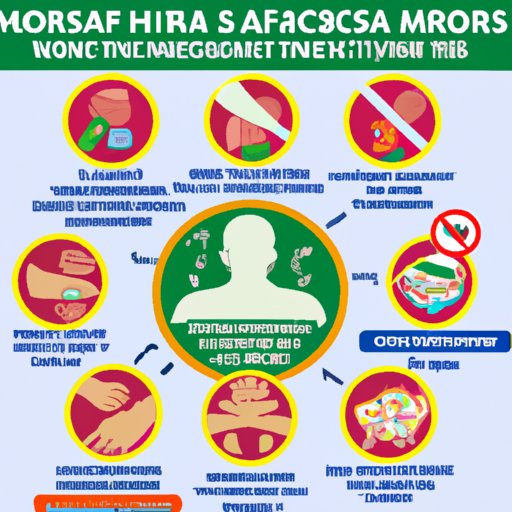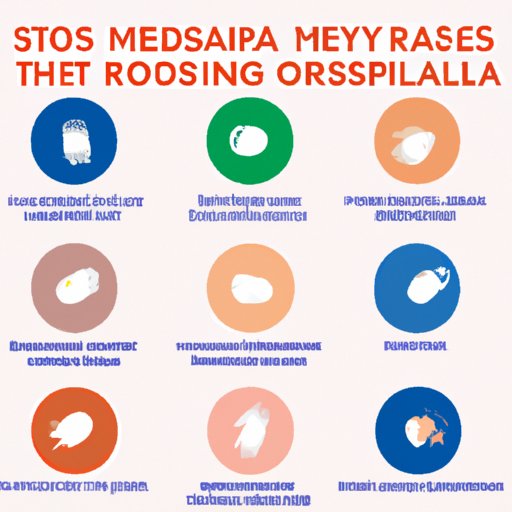
Introduction
MRSA, or methicillin-resistant Staphylococcus aureus, is a type of bacteria that is resistant to many antibiotics. It can cause infections that range from mild to life-threatening, and can affect anyone, regardless of age or health status. In recent years, MRSA has become a major concern for healthcare providers and the general public alike. It is important to know the warning signs of MRSA and what to do if you suspect you have it. In this article, we’ll cover the different symptoms of MRSA and provide you with tips for prevention and seeking medical help.
10 Warning Signs: Do You Have MRSA?
MRSA can cause a variety of symptoms, and it’s important to know what to look out for. Here are 10 warning signs that you may have MRSA:
- Redness and Swelling Around a Cut or Wound
- Pus or Drainage from a Wound
- Fever
- Headaches or Muscle Aches
- Skin Rash
- Chest Pain or Shortness of Breath
- Joint Pain or Swelling
- Fatigue
- General Malaise
- Boils or Abscesses
If you have a cut or wound that becomes red, swollen, or painful, it may be a sign of MRSA. MRSA can cause skin infections that are often mistaken for spider bites or other types of skin irritation.
If the area around a cut or wound begins to produce pus or other drainage, it could be a sign of MRSA. Pus is a thick, yellowish liquid that can be a sign of infection.
Fever is a common symptom of MRSA and can occur when the infection has spread beyond the skin. If you have a persistent fever or feel feverish, it’s important to seek medical attention.
MRSA can cause flu-like symptoms, including headaches, muscle aches, and general fatigue. If you experience these symptoms in conjunction with other warning signs, it’s important to seek medical help.
MRSA can cause a skin rash that is often red and itchy. The rash may be mistaken for eczema or other types of skin irritation, so it’s important to be aware of other symptoms that may accompany the rash.
In severe cases, MRSA can cause pneumonia or other respiratory problems that can lead to chest pain or shortness of breath. Seek medical attention immediately if you experience these symptoms.
MRSA can also cause joint pain or swelling, particularly in the knees, elbow, or shoulder. If you have joint pain that is accompanied by any of the other warning signs, seek medical attention immediately.
MRSA can cause fatigue that is often mistaken for general tiredness. If you experience persistent fatigue in addition to other warning signs, seek medical attention.
If you feel generally unwell and experience a combination of the above symptoms, it may be a sign of MRSA. Seek medical attention immediately.
MRSA can cause boils or abscesses, which are painful lumps that contain pus. The boils or abscesses may be mistaken for spider bites or other types of skin irritation. Seek medical attention if you have a boil or abscess that is accompanied by any of the other warning signs.
MRSA: Understanding the Symptoms and What to Do Next
MRSA is a bacteria that is spread through direct contact with an infected person or contaminated surface. The bacteria can be found on a person’s skin or in their nose, and can be carried by people who are not experiencing symptoms. It’s important to understand the symptoms of MRSA and what to do if you suspect you have it.
MRSA can cause a variety of symptoms, including skin infections, pneumonia, and sepsis. Skin infections are the most common type of MRSA infection, and symptoms can range from mild to severe. In some cases, MRSA can cause serious infections that can lead to hospitalization or even death.
If you suspect you have MRSA, it’s important to seek medical attention immediately. MRSA infections can be difficult to treat, and early detection is key. Your doctor may prescribe antibiotics or other treatments to help manage the symptoms of MRSA and prevent the infection from spreading.

From Rashes to Boils: A Comprehensive Guide to MRSA Symptoms
MRSA can manifest in a variety of ways, and it’s important to be aware of all the possible symptoms. In addition to the symptoms mentioned earlier, MRSA can cause:
- Skin infections that develop into abscesses or boils
- Blisters or skin ulcers
- Cellulitis, which is a type of skin infection that causes redness and swelling
- Sepsis, which is a potentially life-threatening condition that occurs when the infection spreads throughout the body
- Endocarditis, which is an infection of the heart
- Osteomyelitis, which is an infection of the bone
If you have any of these symptoms, it’s important to seek medical attention immediately. In some cases, MRSA can cause serious infections that require hospitalization and long-term treatment.
Preventing MRSA is key, and there are several ways that you can reduce your risk of infection. Here are some tips:
- Wash your hands regularly with soap and water, especially after touching equipment or surfaces in a public place
- Avoid sharing personal items, such as towels or razors, with others
- Cover open cuts or wounds with a clean, dry bandage
- Clean and disinfect surfaces in your home or workplace regularly
- Avoid contact with people who have visible symptoms of MRSA
The Silent Danger: How MRSA Can Go Undetected
MRSA can be difficult to detect, as it can spread without causing visible symptoms. In some cases, people may be unaware that they are carriers of the bacteria and can transmit it to others without knowing.
In addition to the tips mentioned earlier, there are additional steps you can take to reduce your risk of infection:
- Get vaccinated for influenza and other respiratory illnesses
- Avoid sharing food or drinks with others
- Use a barrier, such as a towel or clothing, to minimize skin-to-skin contact with others
- Avoid unnecessary antibiotic use, as this can contribute to antibiotic resistance
Myths and Facts About MRSA Symptoms
There are several common misconceptions about MRSA symptoms, and it’s important to know the facts. Here are some common myths about MRSA:
- Myth: MRSA always causes visible symptoms.
- Fact: MRSA can be transmitted by carriers who do not have visible symptoms.
- Myth: MRSA only affects people who are in hospitals or healthcare settings.
- Fact: MRSA can affect anyone, regardless of age or health status.
- Myth: MRSA is always resistant to all antibiotics.
- Fact: MRSA may be resistant to some antibiotics, but there are still effective treatment options available.
- Myth: MRSA is always fatal.
- Fact: MRSA can cause serious infections, but with proper treatment, most people recover.
By understanding the facts about MRSA, you can take steps to prevent infection and seek medical help if necessary.
When to Seek Medical Help for MRSA Symptoms
If you experience any of the symptoms mentioned in this article, it’s important to seek medical attention immediately. In addition, if you have a fever or any other symptoms that suggest the infection has spread beyond the skin, seek medical attention right away.
If you are hesitant to seek medical help, here are some tips:
- Talk to your doctor about your concerns
- Ask a friend or family member to accompany you to your appointment
- Bring a list of questions to ask your doctor
- Stay informed about MRSA and its symptoms
Surviving MRSA: Stories from Real People
MRSA can be a scary and difficult infection to deal with, but with proper treatment and care, many people recover. Here are some stories from real people who have survived MRSA:
“I was diagnosed with MRSA after I developed a rash on my leg that wouldn’t go away. I was terrified, but my doctor prescribed antibiotics and the infection cleared up within a few weeks. Now I take extra precautions to avoid contact with people who may have MRSA, and I always wash my hands regularly.”
– Sarah, age 34
“My son developed MRSA after he contracted a cut at school. He had surgery to remove the infection and was hospitalized for several weeks. It was a scary and stressful time, but with the help of his healthcare team, he made a full recovery. We now take extra precautions to make sure he Avoids contact with other children who may be carrying the bacteria.”
– Jill, mother of a 6-year-old boy
These stories illustrate the importance of seeking medical help if you suspect you have MRSA, and taking precautions to prevent further infections.
Conclusion
MRSA is a serious infection that can have a variety of symptoms. It’s important to be aware of the warning signs and seek medical attention immediately if you suspect you have the infection. By following the tips in this article, you can reduce your risk of infection and stay healthy. Remember to always wash your hands, cover wounds, and avoid contact with others who may be carrying MRSA.
If you have any concerns or questions about MRSA or its symptoms, talk to your doctor or healthcare provider.




